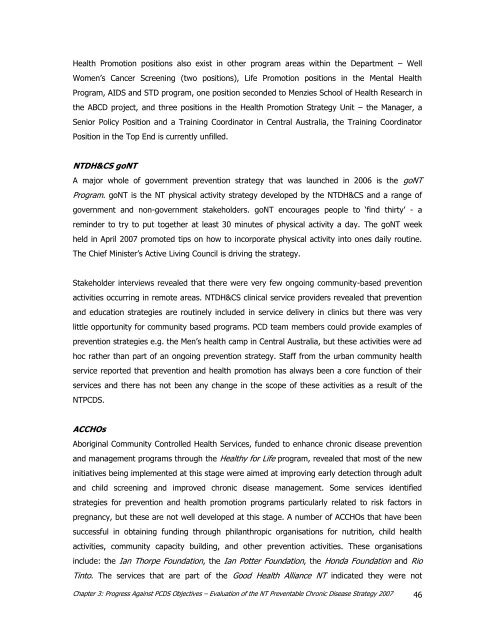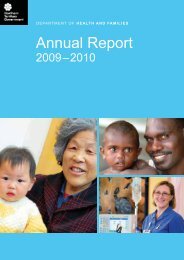PCD Strategy Evaluation 2007.pdf - NT Health Digital Library ...
PCD Strategy Evaluation 2007.pdf - NT Health Digital Library ...
PCD Strategy Evaluation 2007.pdf - NT Health Digital Library ...
Create successful ePaper yourself
Turn your PDF publications into a flip-book with our unique Google optimized e-Paper software.
<strong>Health</strong> Promotion positions also exist in other program areas within the Department – WellWomen‟s Cancer Screening (two positions), Life Promotion positions in the Mental <strong>Health</strong>Program, AIDS and STD program, one position seconded to Menzies School of <strong>Health</strong> Research inthe ABCD project, and three positions in the <strong>Health</strong> Promotion <strong>Strategy</strong> Unit – the Manager, aSenior Policy Position and a Training Coordinator in Central Australia, the Training CoordinatorPosition in the Top End is currently unfilled.<strong>NT</strong>DH&CS go<strong>NT</strong>A major whole of government prevention strategy that was launched in 2006 is the go<strong>NT</strong>Program. go<strong>NT</strong> is the <strong>NT</strong> physical activity strategy developed by the <strong>NT</strong>DH&CS and a range ofgovernment and non-government stakeholders. go<strong>NT</strong> encourages people to „find thirty‟ - areminder to try to put together at least 30 minutes of physical activity a day. The go<strong>NT</strong> weekheld in April 2007 promoted tips on how to incorporate physical activity into ones daily routine.The Chief Minister‟s Active Living Council is driving the strategy.Stakeholder interviews revealed that there were very few ongoing community-based preventionactivities occurring in remote areas. <strong>NT</strong>DH&CS clinical service providers revealed that preventionand education strategies are routinely included in service delivery in clinics but there was verylittle opportunity for community based programs. <strong>PCD</strong> team members could provide examples ofprevention strategies e.g. the Men‟s health camp in Central Australia, but these activities were adhoc rather than part of an ongoing prevention strategy. Staff from the urban community healthservice reported that prevention and health promotion has always been a core function of theirservices and there has not been any change in the scope of these activities as a result of the<strong>NT</strong><strong>PCD</strong>S.ACCHOsAboriginal Community Controlled <strong>Health</strong> Services, funded to enhance chronic disease preventionand management programs through the <strong>Health</strong>y for Life program, revealed that most of the newinitiatives being implemented at this stage were aimed at improving early detection through adultand child screening and improved chronic disease management. Some services identifiedstrategies for prevention and health promotion programs particularly related to risk factors inpregnancy, but these are not well developed at this stage. A number of ACCHOs that have beensuccessful in obtaining funding through philanthropic organisations for nutrition, child healthactivities, community capacity building, and other prevention activities. These organisationsinclude: the Ian Thorpe Foundation, the Ian Potter Foundation, the Honda Foundation and RioTinto. The services that are part of the Good <strong>Health</strong> Alliance <strong>NT</strong> indicated they were notChapter 3: Progress Against <strong>PCD</strong>S Objectives – <strong>Evaluation</strong> of the <strong>NT</strong> Preventable Chronic Disease <strong>Strategy</strong> 2007 46
















